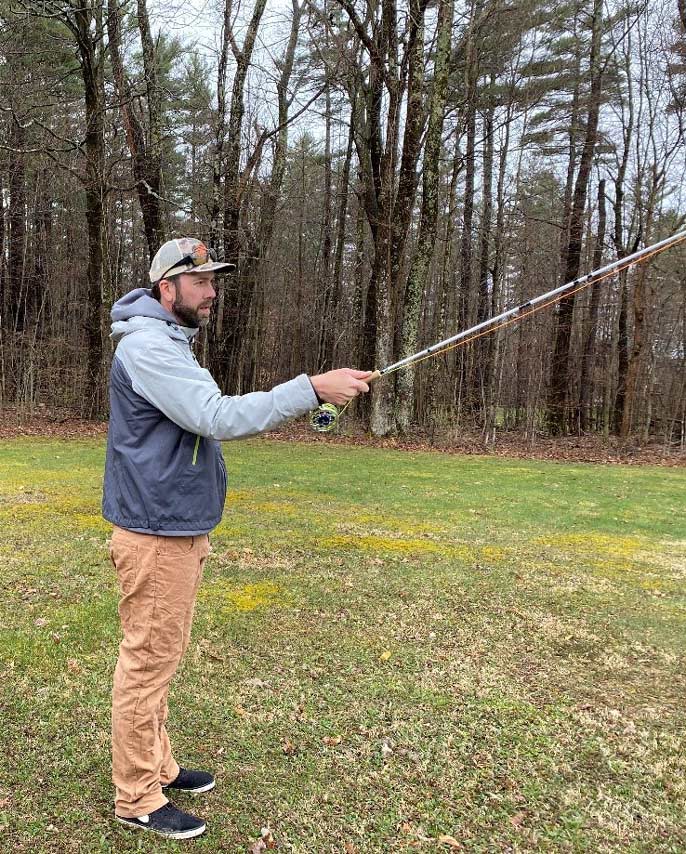Written by: Pete Kutzer, Orvis Fly-Fishing Schools
Welcome to the third installment of “Home School with Pete Kutzer,” a series of how-to fly fishing posts focused on helping us all become a little better casters while practicing proper social distancing: staying at (or very close to) home. In the first part in this series, How to Practice at Home for Fishing, Pete Kutzer, an Orvis Fly-Fishing Instructor for nearly two decades, did a little Q&A on how to stay busy at home—breaking down the basic cast to check your mechanics, and suggesting some options for indoor fun, too. This week, Pete discusses how to ensure you get good distance and accuracy on your roll cast.
— Caitie Caroleo, Orvis Adventures Marketing Specialist
Roll casts are a very important tool to have in your casting arsenal. Aside from being one of my personal favorite casts, the roll cast is one of the most used casts and a great skill to practice at home.
The three most common reasons you need a roll cast are:
- You can’t make a back cast, oftentimes due to tight cover.
- You need to quickly straighten out your line, allowing you to pick line up easier for a good back cast (if the space is available).
- If you are fishing with sinking line, incorporating a roll cast prior to making your back cast helps brings the fly closer to the surface of the water, making the back cast easier, improving your accuracy.
The seemingly simple roll cast can be difficult to master, especially when you’re first starting out. The most common issue I see in roll casts is that the line goes out a few feet, and then “dumps” in a pile in front of the caster. We all know that this is rarely useful.
I think one of the reasons this is such a common outcome has a lot to do with the term “roll cast” itself. When we think of the word “roll,” we imagine something (like a ball) rolling on the ground or on the water. In actuality, a good roll cast should unroll above the water, slowly unfurling, and straightening out. Then, you gently lay the straightened line down on top of the water. How we imagine the “roll” part of the roll cast can be one of the biggest hurdles to overcome. Now that we have the overall concept defined a little more clearly, let’s talk about how to practice a roll cast at home.

When you work at home on your roll cast, make sure to start with a static length of line pinched off under your index or middle finger of your casting hand.
You want to keep a consistent length of line while you work on casting, so we can identify challenges and correct them as quickly as possible. If you are always changing our length of line, it’s even more difficult to identify any possible hiccup in your cast.

To begin a roll cast, start by slowly and smoothly bringing our hand up from the rod lowered position. I like to suggest that your hand comes up parallel to your ear. You can do a roll cast at any angle, but this position is a good starting point to practice. Although you can roll cast at any angle, start somewhere where you can make that cast again and again, until you feel you are getting good results. It is very important to make sure that your fly line stays in contact with the water (or ground, in this case), or you may find yourself dumping your cast.
In this first step I tend to see two common mistakes:
- Rushing right into the forward motion of the
cast. - Keeping our hand low throughout the cast.
The temptation to rush and go right into the cast is very real and happens all the time. Trust me, go slowly, and wait with your hand at the same height as (and parallel to) your ear. Keeping these two things in mind should help to keep you from rushing, and from keeping your hand too low.
To make a roll cast bring your hand forward to the “flick.” This will get your loop to travel out above the water and deliver the fly to your target. If you move our hand downward in this motion, your loop has the tendency to unroll on the water, instead of above it. This can cause a disturbance that may scare fish. It also can cause the line to pile up or dump at the end of the cast, oftentimes stopping short from your target.
Now that we’ve talked about some of the theory behind a roll cast, here’s a breakdown of the basic steps:

- Start with your hand roughly across from your ear.

2. Have your rod slightly tilted to the side to prevent the line from wrapping around or hitting your rod during the cast.

3. Allow your hand to move straight forward toward you target. Smoothly accelerate. . . .

4. . . . into a flick with the rod tip stopping high: around eye level or slightly above.

5. Now watch the loop unroll above the water. . . .

6. . . . and straight out to your target.
Good luck working on your roll cast from home; hopefully you will find it useful out on the water!
Thanks for reading,

Credit: Source link































